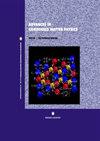Ce-C共掺杂SnO2触点电导率的第一性原理计算
IF 1.8
4区 物理与天体物理
Q3 PHYSICS, CONDENSED MATTER
引用次数: 0
摘要
触头是机械式直流断路器真空断路的核心元件。材料的导电性和焊接电阻直接影响其稳定性和可靠性。AgSnO2触点材料具有电阻率低、耐焊接等特点。该材料在断路器触点材料中占有重要地位。本研究基于密度泛函理论的第一性原理分析方法。本文计算了Ce、C单掺杂和Ce-C共掺杂SnO2体系的晶格常数、焓变、能带、态电子密度、电荷密度分布、居数和电导率。结果表明,Ce、C单掺杂和Ce-C共掺杂均增加了电池体积和晶格常数。元素共掺杂时,焓变最大,热稳定性最好。它具有最小的带隙、最多的杂质能级和最少的电子跃迁所需的能量。Ce原子的4f轨道电子和C原子的2p轨道电子是费米能级附近杂质能量的来源。当元素共掺杂时,在导带的底部和价带的顶部产生更多的杂质能级。其带隙减小,电导率提高。从电荷密度和居群分析来看,共掺杂后Ce原子和C原子的自由电子数被重新分配。形成Ce-C共价键,进一步提高电子的通用性,提高金属丰度。电导率分析表明,单掺杂和共掺杂的电导率均有提高。当元素共掺杂时,电导率最大,电导率最好。本文章由计算机程序翻译,如有差异,请以英文原文为准。
First-Principles Calculation of Conductivity of Ce-C Codoped SnO2 Contacts
The contact is the core element of the vacuum interrupter of the mechanical DC circuit breaker. The electrical conductivity and welding resistance of the material directly affect its stability and reliability. AgSnO2 contact material has low resistivity, welding resistance, and so on. This material occupies an important position of the circuit breaker contact material. This research is based on the first-principles analysis method of density functional theory. The article calculated the lattice constant, enthalpy change, energy band, electronic density of state, charge density distribution, population, and conductivity of Ce, C single-doped, and Ce-C codoped SnO2 systems. The results show that Ce, C single doping, and Ce-C codoping all increase the cell volume and lattice constant. When the elements are codoped, the enthalpy change is the largest, and the thermal stability is the best. It has the smallest bandgap, the most impurity energy levels, and the least energy required for electronic transitions. The 4f orbital electrons of the Ce atom and the 2p orbital electrons of C are the sources of impurity energy near the Fermi level. When the elements are codoped, more impurity energy levels are generated at the bottom of the conduction band and the top of the valence band. Its bandgap is reduced so conductivity is improved. From the charge density and population analysis, the number of free electrons of Ce atoms and C atoms is redistributed after codoping. It forms a Ce-C covalent bond to further increase the degree of commonality of electrons and enhance the metallicity. The conductivity analysis shows that both single-doped and codoped conductivity have been improved. When the elements are codoped, the conductivity is the largest, and the conductivity is the best.
求助全文
通过发布文献求助,成功后即可免费获取论文全文。
去求助
来源期刊

Advances in Condensed Matter Physics
PHYSICS, CONDENSED MATTER-
CiteScore
2.30
自引率
0.00%
发文量
33
审稿时长
6-12 weeks
期刊介绍:
Advances in Condensed Matter Physics publishes articles on the experimental and theoretical study of the physics of materials in solid, liquid, amorphous, and exotic states. Papers consider the quantum, classical, and statistical mechanics of materials; their structure, dynamics, and phase transitions; and their magnetic, electronic, thermal, and optical properties.
Submission of original research, and focused review articles, is welcomed from researchers from across the entire condensed matter physics community.
 求助内容:
求助内容: 应助结果提醒方式:
应助结果提醒方式:


